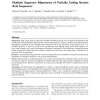Free Online Productivity Tools
i2Speak
i2Symbol
i2OCR
iTex2Img
iWeb2Print
iWeb2Shot
i2Type
iPdf2Split
iPdf2Merge
i2Bopomofo
i2Arabic
i2Style
i2Image
i2PDF
iLatex2Rtf
Sci2ools
BMCBI
2005
2005
Multiple sequence alignments of partially coding nucleic acid sequences
Background: High quality sequence alignments of RNA and DNA sequences are an important prerequisite for the comparative analysis of genomic sequence data. Nucleic acid sequences, however, exhibit a much larger sequence heterogeneity compared to their encoded protein sequences due to the redundancy of the genetic code. It is desirable, therefore, to make use of the amino acid sequence when aligning coding nucleic acid sequences. In many cases, however, only a part of the sequence of interest is translated. On the other hand, overlapping reading frames may encode multiple alternative proteins, possibly with intermittent non-coding parts. Examples are, in particular, RNA virus genomes. Methods: The standard scoring scheme for nucleic acid alignments can be extended to incorporate simultaneously information on translation products in one or more reading frames. Results: Here we present a multiple alignment tool, codaln, that implements a combined nucleic acid plus amino acid scoring model...
Related Content
| Added | 15 Dec 2010 |
| Updated | 15 Dec 2010 |
| Type | Journal |
| Year | 2005 |
| Where | BMCBI |
| Authors | Roman R. Stocsits, Ivo L. Hofacker, Claudia Fried, Peter F. Stadler |
Comments (0)

